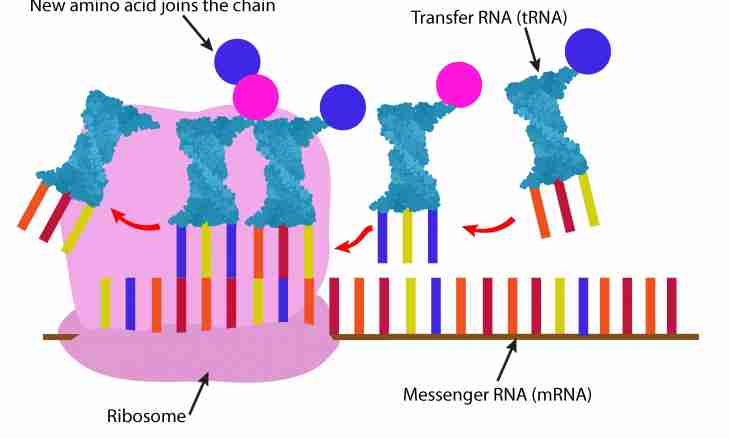Nucleinic acids are high-molecular connections (polynucleotides) playing a huge role in storage and transfer of hereditary information at living organisms. Distinguish deoxyribonucleic (DNA) and ribonucleic (RNA) acids.
What RNA types exist
In living cell there are three RNA types: ribosomal, transport and information (matrix) ribonucleic acids. All of them differ on structure, the size of molecules, localizations in a cage and the carried-out functions.
What characterizes ribosomal RNA (rRNK)
Ribosomal RNA make 85% of all RNA of a cage. They are synthesized in a kernel. Ribosomal RNA are a structural component of ribosomes and are directly involved in protein biosynthesis.
Ribosomes are the organelles of a cage consisting of four rRNK and several dozen proteins. Their main function – protein synthesis.
Why transport RNA are necessary
Transport RNA (tRNK) – the smallest by the size ribonucleic acids of a cage. They make 10% of all cellular RNA. Transport RNA are formed in a kernel on DNA and then pass into cytoplasm. Each tRNK transfers certain amino acids to ribosomes where they connect peptide communications in the special sequence set by matrix RNA.B to a molecule of transport RNA there are two active sites: triplet anti-codon and acceptor end. The acceptor end is "airfield" for amino acid. The anti-codon on other end of a molecule represents a triplet of nucleotides, complementary to the corresponding codon of information RNA.
To each amino acid there corresponds the sequence of three nucleotides – a triplet. The nucleotide is the monomer of nucleinic acids consisting of phosphatic group, pentose and the nitrogenous basis.
The anti-codon is various for tRNK transporting different amino acids. In a triplet information on that amino acid which is transferred by this molecule is coded.
Where matrix RNA are synthesized and in what their role
Information, or matrix RNA (iRNK, mRNK) are synthesized on the site of one of two chains of DNA under the influence of RNA polymerase enzyme. They make 5% of RNA of a cage. The sequence of the nitrogenous bases of iRNK is strictly complementary the sequences of foundations of the site of DNA: to DNA adenine there corresponds iRNK uracil, to thymine – adenine, to guanine – tsitozin and to a tsitozin – guanine. Matrix RNA reads out hereditary information from chromosomal DNA and transfers it to ribosomes where this information is implemented. In the sequence of nucleotides of iRNK information on structure of protein is encrypted. Molecules RNA can be in a kernel, cytoplasm, ribosomes, mitochondrions and plastids. Of different types of RNA there is a uniform functional system directed by means of synthesis of protein to implementation of hereditary information.

